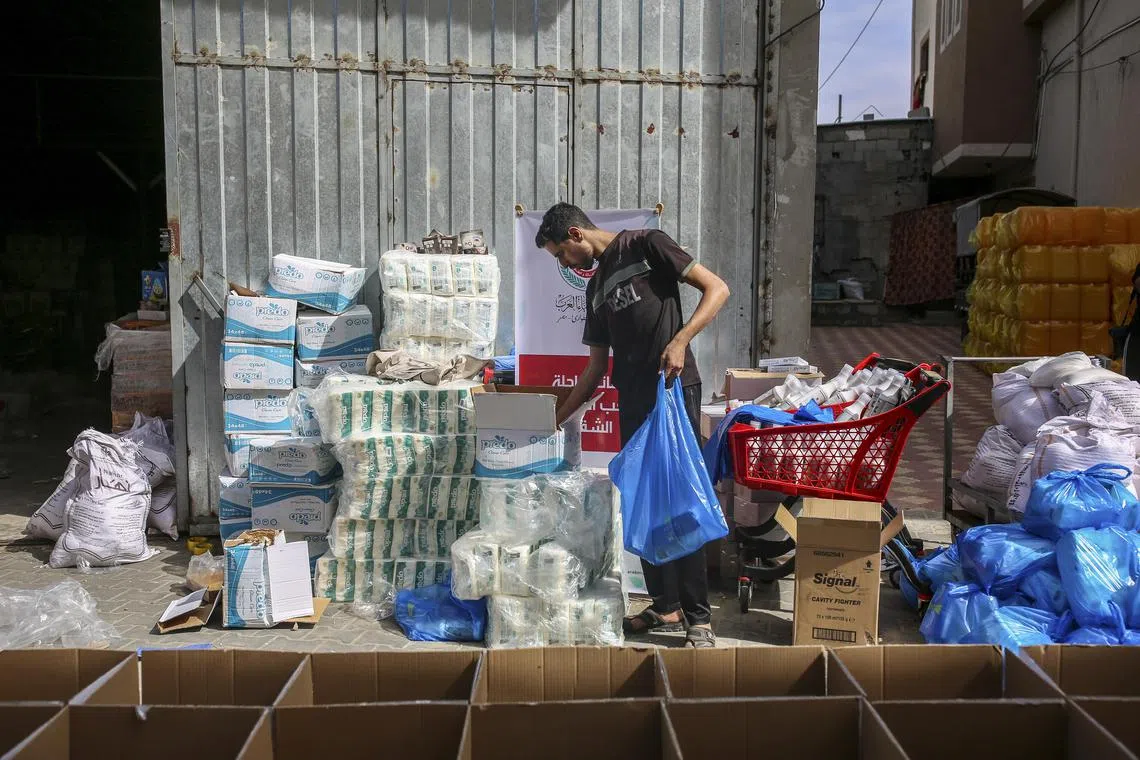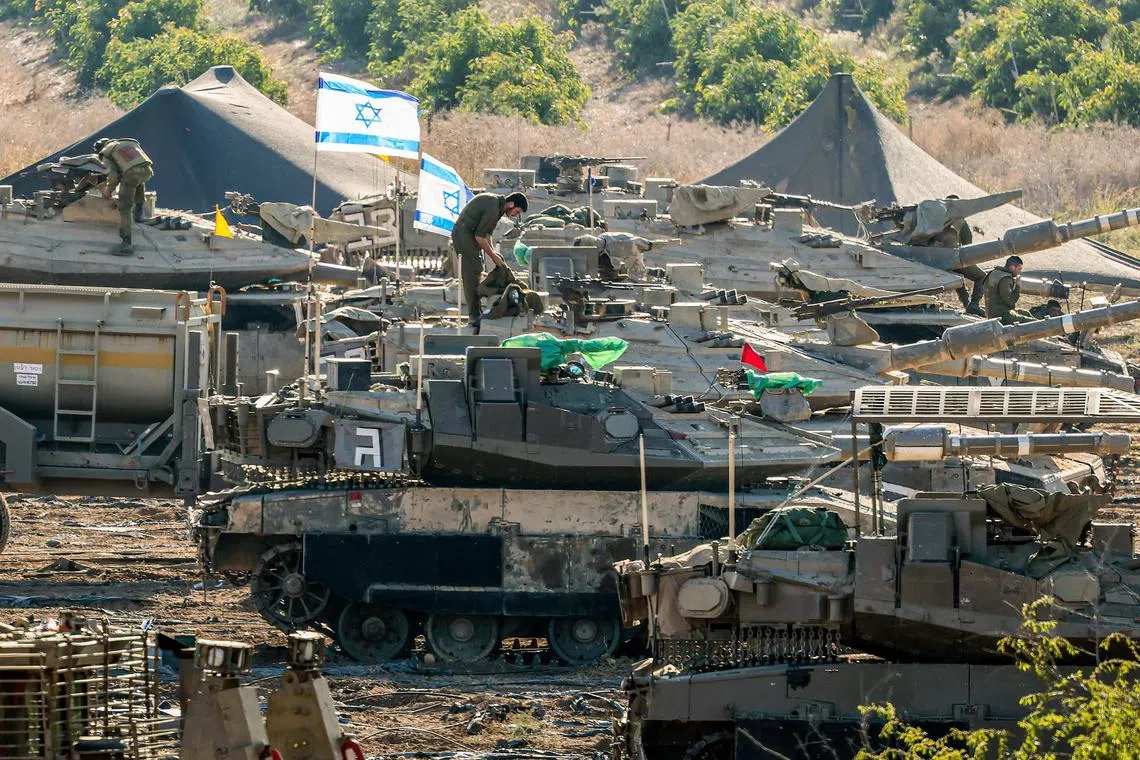First emergency convoy reaches Gaza; Israel says it will intensify strikes
Sign up now: Get ST's newsletters delivered to your inbox
Follow topic:
GAZA/JERUSALEM - Israel pounded southern Gaza with air strikes early on Sunday and said it would intensify its attacks in the enclave’s north, as the United States committed to getting more aid to Palestinians running out of food, water, medicines and fuel.
Palestinian media reported at least 11 Palestinians were killed in an Israeli strike in the southern Gaza city of Khan Younis. Palestinian media also said Israel was striking the southern city of Rafah.
The overnight strikes came hours after the Israeli military’s spokesman, Rear Admiral Daniel Hagari, called on Gazans to move south out of harm’s way.
“For your own safety, move southward. We will continue to attack in the area of Gaza City and increase attacks,” he said in a briefing to Israeli reporters on Saturday. crossed into southern Gaza on Saturday
“The humanitarian aid that has entered to UNRWA (United Nations Relief and Works Agency), from Egypt, we are supervising it to ensure that the water medicine and water are distributed in this humanitarian area we have set.”
A long-awaited convoy of trucks carrying humanitarian aid
US President Joe Biden cheered the arrival of the aid after days of intense negotiations and said the US was committed to ensuring that more assistance would enter via southern Gaza Strip’s Rafah border point with Egypt.
“We will continue to work with all parties to keep the Rafah crossing in operation,” he said in a statement.
Twenty flatbed trucks, flying white flags and honking their horns, exited the crossing after checks and headed into Gaza’s southern area, which includes the major towns of Rafah and Khan Younis, where hundreds of thousands of people made homeless by Israel’s unrelenting air war are sheltering.
Israel added 14 communities to its evacuation plan in the north of the country, said a joint statement by the Defence Ministry and military on Sunday.
The communities outlined in the statement, which were approved by Defence Minister Yoav Gallant, lie close to Lebanon and Syria.
Israel’s “total siege” of Gaza, launched after the Oct 7 cross-border attack on southern Israel
But the United Nations humanitarian office said the volume of goods that entered on Saturday was equivalent to about 4 per cent of the daily average of imports into Gaza prior to the hostilities. Palestinian officials were disappointed that fuel supplies were not included in the consignment.
“Excluding the fuel from the humanitarian aid means the lives of patients and injured will remain at risk. Gaza hospitals are running out of the basic requirements to pursue medical interventions,” the Gaza Health Ministry said.
The UN said the convoy, which included life-saving supplies, would be received and distributed by the Palestine Red Crescent, with the consent of Hamas, which rules Gaza.
US Secretary of State Antony Blinken welcomed the opening but echoed a warning from Israel that no aid should end up in Hamas hands.
“We have been clear: Hamas must not interfere with the provision of this life-saving assistance,” he said in a statement.
UN officials say that at least 100 trucks are needed daily and that any aid operation must be sustainable at scale – a tall order with Israel carrying out bombardments day and night that have wrecked entire populated districts.
Before the outbreak of conflict, an average of about 450 aid trucks were arriving daily in Gaza.
No breakthrough in Cairo
Diplomacy to secure a ceasefire has been fruitless so far.
Arab leaders at a hastily convened Cairo summit on Saturday condemned the Israeli bombardment of Gaza
Late on Saturday, the US proposed a draft UN Security Council resolution that says Israel has a right to defend itself. The resolution also demands that Iran stop exporting arms to “militias and terrorist groups threatening peace and security across the region”.
Israel had kept up air strikes on targets around Gaza in Saturday’s early hours, after Prime Minister Benjamin Netanyahu vowed to “fight until victory” following the release of the first two hostages by Hamas.

An aid distribution point for Palestinian citizens in southern Gaza, on Oct 21.
PHOTO: NYTIMES
Hamas on Friday freed Americans Judith Tai Raanan, 59, and her daughter Natalie, 17, who were among around 210 people kidnapped in Hamas’ Oct 7 assault on southern Israel. Hamas said it acted in part “for humanitarian reasons” in response to Qatari mediation.
Hamas gunmen seized the hostages when they burst out of the blockaded enclave into Israel and killed 1,400 people, mainly civilians, in a shock rampage.
Gaza’s Health Ministry said on Saturday that Israel’s air and missile strikes had killed at least 4,385 Palestinians, including hundreds of children, while over a million of the territory’s people have been displaced.
Israel has amassed tanks and troops near the fenced border around the narrow coastal enclave for a planned ground invasion, with the objective of annihilating Hamas, after several inconclusive wars dating to its seizure of power there in 2007.

Israeli soldiers and armoured vehicles gathered at an undisclosed location near the border with Gaza, in Israel, on Oct 21.
PHOTO: EPA-EFE
In a video distributed by the Israeli military, Chief of Staff Lieutenant General Herzi Halevi told troops: “We are going to go into the Gaza Strip... to destroy Hamas operatives and Hamas infrastructure, and we will have in our mind the memories of the images and those who fell on Saturday two weeks ago.”
Israeli troops have carried out live fire drills “in preparations for the next stage of war”, footage released by the Israeli army on Saturday showed.
Amid mounting international concern that the conflict could widen, Mr Blinken on Saturday cautioned Lebanon’s caretaker Prime Minister Najib Mikati in a call that the Lebanese people would be affected if his country were drawn into the war, the State Department said.
Iran-backed Lebanese group Hezbollah and Israel’s military have been trading fire at the frontier almost daily, and Hezbollah said on Saturday that several of its fighters were killed.
In Iraq, a security source said two drones were shot down near the Ain al-Asad air base, which hosts US forces. However, a US defence official told Reuters that he could not corroborate that account. US troops have come under repeated attack in Syria and Iraq in recent days.
‘Some way to go’
Overnight, Israeli fighter jets struck a “large number of Hamas terror targets throughout” Gaza, including command centres and combat positions inside multi-storey buildings, the military said in a statement.
Gaza’s Health Ministry and Hamas media said Israeli aircraft targeted several family houses across Gaza, killing at least 50 people and injuring dozens.
Hamas said it fired rockets towards Israeli’s biggest city Tel Aviv on Saturday in response to those deaths. The Israeli military reported a fresh salvo of rockets from Gaza against southern Israeli border communities before dawn.
A senior Israeli military official who declined to be named said Israel had killed “a few thousand” Hamas militants in the war. “It is not enough. We need to take more... We are looking at a long campaign. They are already hurting, but there is still some way to go,” he said.
He said the air force had targeted some militants in their own homes, including overnight, and acknowledged that civilians living nearby might have been hurt.
‘Drop in the ocean’
Most of Gaza’s inhabitants depend on humanitarian aid. The heavily urbanised and widely impoverished territory has been under Israeli and Egyptian blockade since Israel unilaterally withdrew from the enclave in 2005.
Israel has told all civilians to evacuate the northern half of Gaza, which includes Gaza City. Many people have yet to leave, saying they fear losing everything and have nowhere safe to go, given that southern areas have also been bombarded.
Some said the aid arriving on Saturday was too little to make a difference.
“This is a drop in the ocean. You are trying to show the world that you are bringing aid. This is throwing dust in the eyes,” said Mr Nabil El-Dhaba, a resident of the Shejaia district in Gaza City who has been displaced to Deir Al-Balah in the southern Gaza Strip. REUTERS

